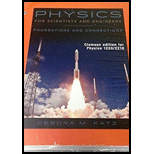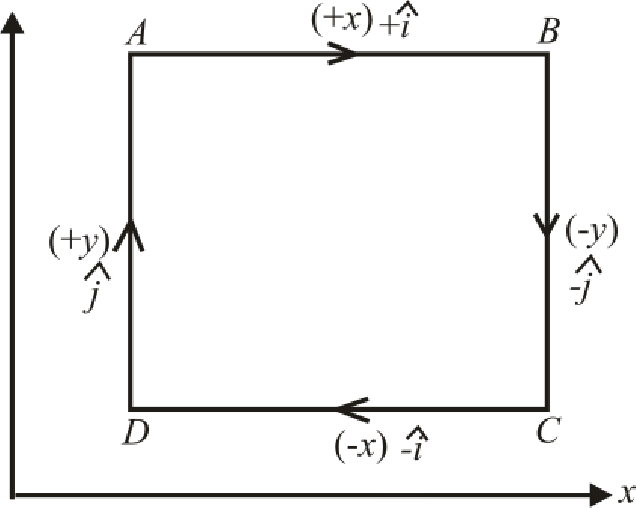
Concept explainers
The contribution to the circulation integral due to each segment of the loop, and the net current through the loop that must be present.
Answer to Problem 17PQ
The contribution of side 1 is
Explanation of Solution
Draw the figure for the system as shown below:

Refer to the above figure, consider a square loop
Write the general expression for Ampere’s Circuital Law for the given above figure as.
Here,
Substitute
Substitute
Substitute
Substitute
Conclusion:
Substitute
Further,simplify the above equation as.
Thus, contribution of side
Substitute
Further,simplify the above equation as.
Thus, contribution of side
Substitute
Further,simplify the above equation as.
Thus, the contribution of side
Substitute
Further,simplify the above equation as.
Thus, the contribution of side
Thus, the contribution of side 1 is
Want to see more full solutions like this?
Chapter 31 Solutions
Physics for Scientists and Engineers: Foundations and Connections
- A current loop with magnetic dipole moment is placed in a uniform magnetic field , with its moment making angle θ with the field. With the arbitrary choice of U = 0 for θ = 90°, prove that the potential energy of the dipole-field system is .arrow_forwardA proton moving at speed v = 1.00 x 106 m/s enters a region in space where a magnetic fi eld givenby B = (–0.500 T) z exists. The velocity vector of the proton is at an angle θ = 60.0° with respect tothe positive z-axis. a) Analyze the motion of the proton and describe its trajectory (in qualitativeterms only). b) Calculate the radius, r, of the trajectory projected onto a plane perpendicular to themagnetic fi eld (in the xy-plane). c) Calculate the period, T, and frequency, f, of the motion in thatplane. d) Calculate the pitch of the motion (the distance traveled by the proton in the direction ofthe magnetic fi eld in 1 period).arrow_forwardA closely wound solenoid of 2000 turns and area of cross-section 1.6×10 −4 m 2 carrying 4.0 A current, is suspended through its centre, thereby allowing it to turn in a horizontal plane. What is the magnetic moment associated with the solenoid?arrow_forward
- )A flat circular loop of radius 1.49 m is rotating in a uniform magnetic field of 1.46 T. Find the magnetic flux, in T m2, through the loop when the plane of the loop and the magnetic field vector are perpendicular.arrow_forwardA 5cm by 5cm rectangular coil of wire with 500 turns carrying a current of 0.1 amos comprising the armature of an electric motor lies in the xy plane. The coil is subjected to a uniform magnetic field B with strength 0.05 Tesla in the z direction as shown in the figure. The armature is free to rotate without friction about the x axis with an assoxiated moment of inertia of 1 x 10^-2 kgm^2. Initially the armature is in the (unstable) equilibriu, with magnetic moment m. antiparallel to B, but it begins to rotate after a slight nudge. What is the change in potential energy, and what is its rotation rate, when m is parallel to B?arrow_forwardA wire segment carrying a current I is bent into a sinusoidal shape with period of 2π, i.e., y=sin(x) and the wire has length 2π in the x−direction. There is a magnetic field in the vicinity of the wire which points in the positive z−direction with a magnitude given by B=B0x. What is the magnitude of the y−component of the force on the wire segment?arrow_forward
- a rectangular coil of wire consisting of ten loops each with length 0.20 m and width 0.30 m, lies in the xy- plane. if the coil carries a current of 2.0 A, what is the magnitude of the torque exerted by a magnetic field of 0.010 T directed at an angle of 30.0 with respect to the positive z-axisarrow_forwardA circular loop of wire of radius r = 1.0 m is placed in a region where an external uniform magnetic field is perpendicular to the plane of the loop. The external magnetic field vector points in, perpendicular to the page. During the course of 0.150 seconds, the field magnitude B is DECREASED uniformly (i.e., linearly in time) from 0.64 T to 0.25 T. (a) What is the direction of the induced current i in the loop, clockwise or counterclockwise. Please indicate this direction by drawing a curved arrow at the wire. What is the direction of the induced magnetic field, in or out? (b) What is the magnitude ε of the average induced electromotive force (emf)? (c) If the resistance of the wire is 2.00 ohms, then what is the magnitude of the induced current? How much heat is created in a period of 1.0 minute?arrow_forwardI = 7 A current flows from the infinitely long wire along the y axis that intersects the z axis at the point C (0,0,8) in the upper half space, which is the empty space. If z <0 half space, it is made of material with relative magnetic permeability µr = 7. Write the sum of the components of the magnetic field H [A / m] vector at point A (-2, -4,0-) (in half space z <0) in terms of the given magnitudes Hx + Hy + Hz numerically.arrow_forward
- A straight section of wire of length L is along the +x - axis with one end at the origin O of xy - plane. The wire carries a current I and we wish to calculate the magnetic field B at an arbitrary point in the xy - plane with both x, and y as positive.arrow_forwardA particle with charge 5.0x10-6 C is traveling to the right with speed 5.0x103 m/s and enters a region between 2 parallel plates with uniform magnetic field magnitude of 4.0 T and dirceion into the page as shown. What is the magnitude and direction of the electric field if the particle moves through the region without any deflection?arrow_forwardA rod of mass m and resistance R slides without friction in a horizontal plane, moving on parallel rails as shown in figure. The rails are separated by a distance d. A battery that maintains a constant emf ε is connected between the rails, and a constant magnetic field B is directed out of the page. Assuming the rod starts from rest at time t = 0, find its velocity in terms of time t, ε, B, d, m, and R.arrow_forward
 Principles of Physics: A Calculus-Based TextPhysicsISBN:9781133104261Author:Raymond A. Serway, John W. JewettPublisher:Cengage Learning
Principles of Physics: A Calculus-Based TextPhysicsISBN:9781133104261Author:Raymond A. Serway, John W. JewettPublisher:Cengage Learning
